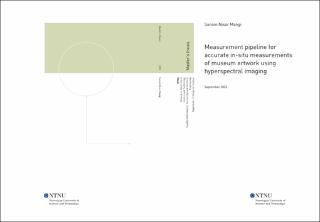| dc.description.abstract | Conservators and researchers recognized the need to study and digitally document the colored artwork that makes up our cultural heritage. These digital documents are then utilised for various applications of preservations, such as, recording changes in appearance and conditions of paintings; pigment identification; investigating materials (such as varnish) present on the artworks; revealing hidden information in paintings; art conservation and art restoration. One of the important aspects of an artwork is its colour, as the artist uses colour to interact with the viewer. Hence, the digital documentation needs an accurate information of the coloured artwork. Hyperspectral imaging, a non-invasive imaging technique has been applied by several studies in a museum setup to acquire the spectral reflectance of a colored artwork. Hyperspectral imaging technique captures both spectral and spatial information of an object. Spectral reflectance is considered as an accurate reproduction. However, for the same object, the acquired information may vary depending on the method of data acquisition, systems used in the acquisition, and overall acquisition setup. However, to the best of our knowledge, there are no procedures or workflows established that assure data reproducibility. In this study, we applied a hyperspectral imaging technique in a museum settings in order to propose measurement pipeline to capture the spectral reflectance of whole surface of the artwork so that it ensures high quality data reproduction.
We have utilised the X-Rite Macbeth Color Checker as a test object to assess the accuracy of the line scanner hyperspectral camera Specim IQ under various experimental studies. To provide ground truth data for comparison, spot measurements are acquired with a JETI specbos 1211 spectroradiometer at each of the 24 patches of Macbeth ColourChecker. A series of experimental tests were conducted to investigate the impact of several aspects impacting the measurements, for-example, use of different light sources in a measurement setup, method of estimation of the illumination of the scene, the measurement geometry, etc. We provide the radiometric, photometric and colorimetric assessment of each of the experimental tests. Radiometric assessments are performed by means of the spectral reflectance curves and for the colorimetric assessment CIELAB and u’v’ Chromaticity diagram (CIE 1976 UCS) units were computed for both CIE illuminant E and CIE D65 for the CIE 1931 2° standard observer.
Our experimental tests revealed that data is indeed influenced by the acquisition parameters. We also identified the colours which results in relatively high inaccuracy. The results of experimental tests are analysed thoroughly to propose the measurement pipeline to be used in museums. We also provide the suggestions and guidelines that can be useful for the researchers and conservators to carry out in-situ acquisitions in the museums. | |
